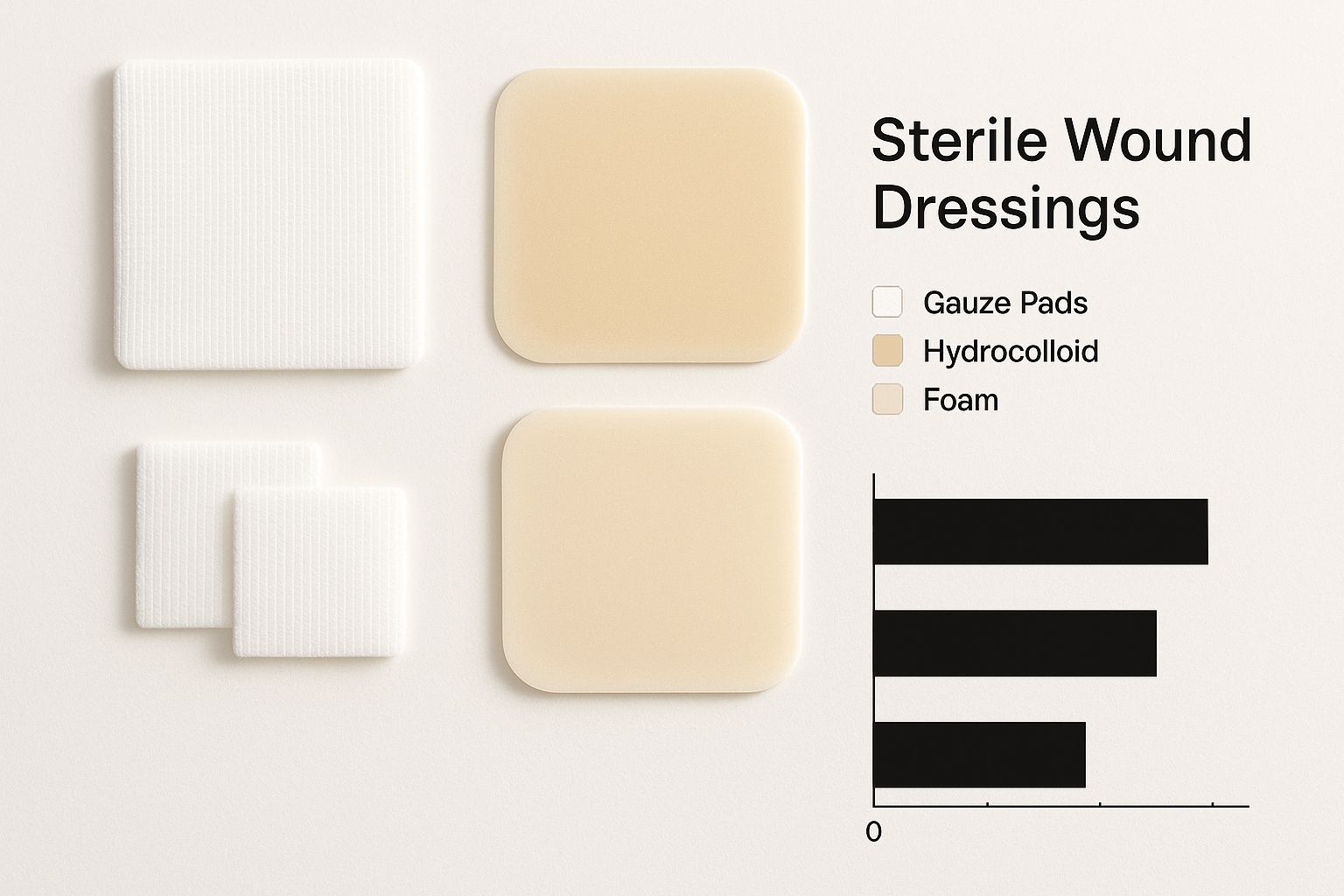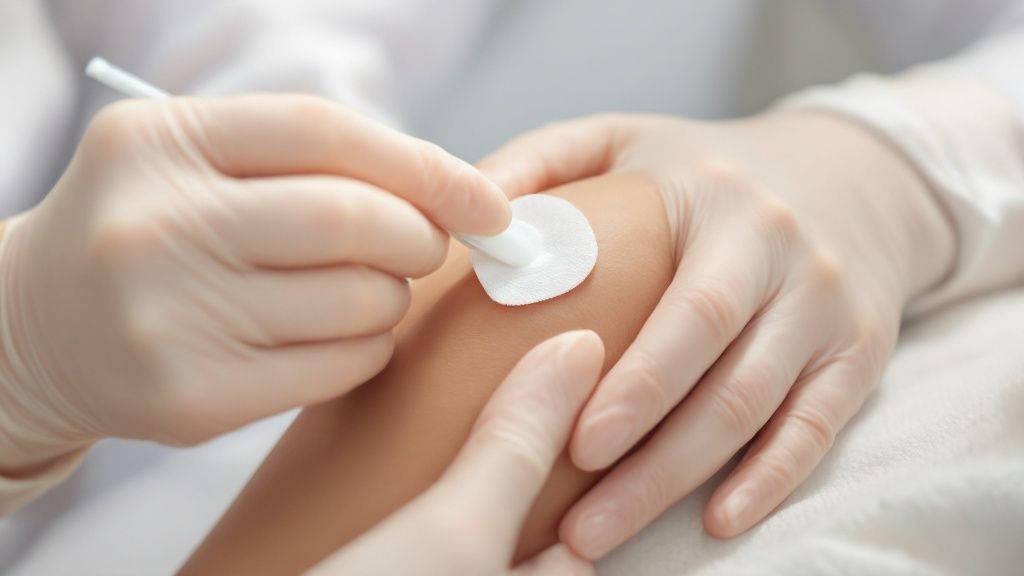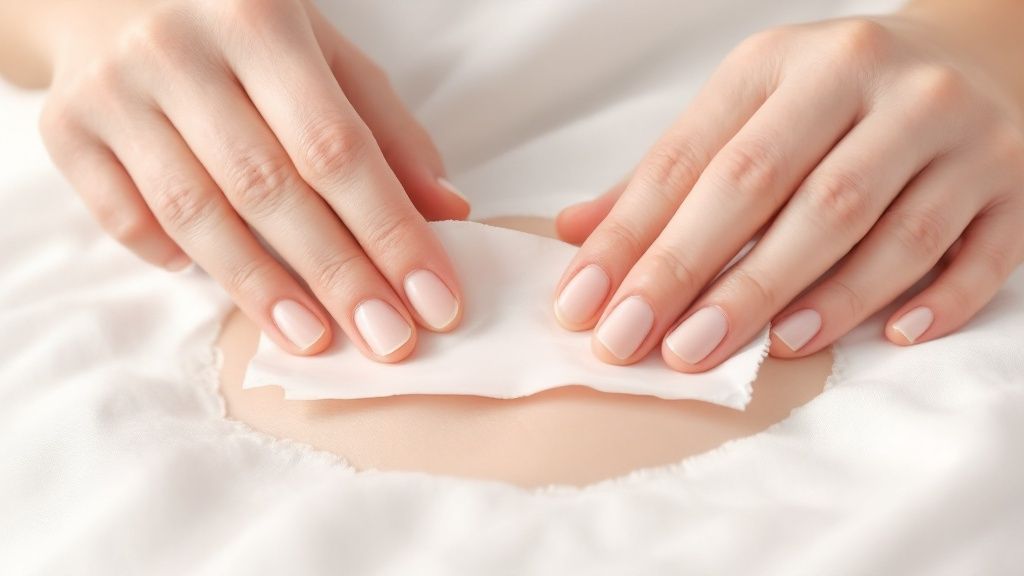Mastering Wound Types: The Foundation of Effective Care
Understanding the nature of a wound is the first step towards effective treatment. This begins with differentiating between acute and chronic wounds. Acute wounds, such as minor cuts or surgical incisions, generally heal within a predictable timeframe. Chronic wounds, like diabetic ulcers or pressure injuries, however, persist for extended periods, often complicated by underlying health issues. These different wound types necessitate distinct approaches to dressing selection and overall management.
The Four Phases of Wound Healing
Wound healing is a complex biological process that progresses through four distinct phases: hemostasis, inflammation, proliferation, and maturation. Hemostasis is the initial phase, involving blood clotting to stop bleeding. The subsequent phase, inflammation, is characterized by redness and swelling as the body cleans the wound. Next, proliferation begins, marked by new tissue growth and the formation of a protective barrier. Finally, maturation involves remodeling the new tissue, improving its strength and flexibility.
Each phase requires specific care strategies to promote optimal healing. For instance, during the inflammation phase, dressings that absorb excess fluid and protect the wound are critical.
Wound Assessment: A Critical Skill
Proper wound assessment is crucial for selecting the appropriate dressing. This involves evaluating key characteristics such as wound depth, signs of infection, and drainage patterns. Wound depth helps determine the required dressing thickness and absorption capacity. Assessing drainage – whether the wound is dry, moderately exuding, or heavily exuding – guides the choice of dressing materials. Recognizing early signs of infection, like increased redness, warmth, or purulent drainage, is vital for prompt intervention.
This careful evaluation forms the basis of a targeted wound dressing strategy. Accurate assessment also allows healthcare professionals to monitor wound progress and adjust treatment as needed. For those interested in learning more about a related field, the following resource offers insights into elder care: Caregiving for the Elderly: Guide to Providing Compassionate Care.
Wound Care Market Growth
The global wound care market, including wound dressings, is experiencing significant growth. As of 2024, the market was valued at USD 23.13 billion, and projections indicate it will reach USD 32.75 billion by 2033, with a CAGR of 3.94%. Factors contributing to this growth include increasing healthcare needs, advancements in wound care technologies, and the rising prevalence of chronic wounds. More detailed statistics are available here: Learn more about Wound Care Market Growth.
Common Wound Types and Characteristics
A deeper understanding of common wound types facilitates accurate assessment and appropriate dressing choices. The following table offers a concise overview:
Common Wound Types and Their Characteristics: A comprehensive overview of different wound categories and their defining features to help with accurate assessment.
| Wound Type | Characteristics | Common Causes | Typical Healing Time | Special Considerations |
|---|---|---|---|---|
| Surgical Wounds | Clean edges, typically closed with sutures or staples | Surgical procedures | Varies depending on the procedure | Risk of infection, proper closure is essential |
| Pressure Injuries | Localized damage to skin and underlying tissue | Prolonged pressure on the skin | Weeks to months | Requires pressure relief and regular assessment |
| Diabetic Ulcers | Often found on the feet, slow to heal | Poor circulation, nerve damage | Weeks to months | Careful monitoring and blood sugar management |
| Burns | Vary in depth and severity | Heat, chemicals, electricity | Varies depending on the severity | Infection control and pain management are crucial |
| Traumatic Wounds | Irregular edges, may involve tissue loss | Accidents, injuries | Varies depending on the severity | Risk of infection, may require debridement |
This table underscores the variety of wound types and the necessity of a tailored approach to wound care. Selecting the appropriate dressing based on these characteristics is paramount for achieving optimal healing outcomes.
Selecting the Right Dressing Materials for Real Results
Navigating the numerous wound dressing options can be daunting. This guide, developed with insights from wound care experts, clarifies the key differences between materials to help you select the best option for specific wound conditions. We'll cover traditional dressings like gauze and modern options like hydrocolloids, alginates, and films.
Key Selection Criteria for Wound Dressings
A wound dressing's effectiveness depends on factors like absorption capacity, moisture retention, and the presence of a bacterial barrier. For instance, a heavily exuding wound needs a highly absorbent dressing, such as an alginate or foam dressing. A dry wound, however, benefits from a hydrogel that adds moisture and promotes healing. Choosing the wrong dressing can slow healing and may even lead to complications.
Wound Dressing Material Comparison
The dressing material should match the wound’s specific needs. Gauze, a time-tested option, is versatile for cleaning and packing wounds. However, it lacks advanced features. Hydrocolloids, conversely, create a moist environment ideal for lightly exuding wounds. Alginates are highly absorbent and suitable for heavily exuding wounds. Films offer a protective barrier but aren't absorbent, making them suitable for superficial wounds. Understanding the nuances of each material is crucial for effective wound management. To help with this, let's look at the table below.
To assist in selecting the right dressing, we've compiled a comparison guide outlining the key features and benefits of various wound dressing materials.
Wound Dressing Materials Comparison Guide
Comparing different wound dressing materials based on key properties to help select the right dressing for specific wound conditions
| Dressing Type | Best For | Absorption Level | Moisture Retention | Change Frequency | Cost Range | Special Features |
|---|---|---|---|---|---|---|
| Gauze | Cleaning and packing wounds | Low | Low | Frequent | Low | Versatile, readily available |
| Hydrocolloid | Lightly exuding wounds | Moderate | High | Less frequent | Moderate | Creates a moist environment, promotes autolytic debridement |
| Alginate | Heavily exuding wounds | High | Moderate | Frequent | Moderate to High | Absorbs excess exudate, forms a gel |
| Film | Superficial wounds | Low | Low | Less frequent | Low to Moderate | Protective barrier, allows for wound monitoring |
| Foam | Moderate to heavily exuding wounds | High | Moderate | Moderate | Moderate | Cushioning, comfortable |
| Hydrogel | Dry wounds | Low | High | Moderate | Moderate to High | Hydrates the wound, promotes autolytic debridement |
This table highlights the diverse properties of various wound dressings, enabling healthcare professionals and patients to make informed choices for optimal wound healing. Selecting the appropriate dressing based on these factors is essential for effective wound care.

This infographic showcases various sterile wound dressing types, emphasizing the range of textures and forms available for different wound needs. This visual comparison underscores the importance of selecting the right dressing based on factors like absorption and intended use.
Antimicrobial Dressings: When and Why?
All dressings contribute to infection prevention. However, antimicrobial dressings contain active agents that specifically target bacteria. These are especially useful for infected wounds or those at high risk of infection. It's important to note that antimicrobial dressings don't replace appropriate systemic antibiotics when necessary. The wound dressing market has grown substantially, partially due to the increasing need for these advanced options. The global market is projected to grow from USD 7.0 billion in 2020 to USD 11.2 billion by 2025, with a CAGR of 7.9%. This growth reflects the increasing demand for advanced wound care solutions. For more detailed statistics, see: Explore Wound Dressing Market Growth.
Specialty Dressings for Challenging Wounds
Some wounds, like diabetic ulcers or pressure injuries, present unique challenges. They require specialized dressings, which may include collagen dressings to stimulate tissue growth, foam dressings with silicone borders for gentle adhesion and cushioning, or negative pressure wound therapy systems for complex or slow-healing wounds. These specialized dressings are often more expensive but can significantly improve outcomes in challenging cases, justifying their cost through better healing and fewer complications.
Matching Dressings to Wound Types
Choosing the right dressing means considering the wound type and its healing stage. A dry wound benefits from a hydrogel to add moisture, while a heavily exuding wound needs a highly absorbent dressing like an alginate. A simple film dressing might be sufficient for a surgical wound. Factors like wound location and the patient's overall health also influence the decision.
Financial Considerations in Dressing Selection
While effectiveness is paramount, cost and insurance coverage are practical considerations. Hydrocolloid dressings are generally less expensive. Alginates and hydrofibers, due to their specialized properties, tend to be more expensive. Understanding insurance coverage for different dressing types helps patients and healthcare providers make informed choices. The goal is to balance cost-effectiveness with optimal healing.
Application Techniques That Transform Healing Outcomes
Choosing the right wound dressing is only half the battle. Even the most advanced dressing won't deliver optimal results if not applied correctly. This section, guided by insights from wound care practitioners, provides step-by-step application protocols proven to dramatically improve healing outcomes. We'll explore everything from essential pre-application steps to specialized techniques for challenging wound locations.
Pre-Application Essentials: Setting the Stage for Success
Before even touching the wound, crucial pre-application steps must be taken. Hand hygiene, following evidence-based protocols, is paramount in preventing infection. This means more than a quick rinse – thorough handwashing with soap and water or using an alcohol-based hand sanitizer is essential. This standard approach maintains the highest level of protection and prevents complications.
Proper wound cleansing is vital for removing debris and bacteria without damaging delicate healing tissue. Normal saline solution is generally recommended. Harsh antiseptic solutions can impair healing. Think of it like gardening – you want to remove the weeds without harming the delicate new growth. Gentle irrigation, rather than aggressive scrubbing, is key.
Maintaining Sterile Technique: More Than Just Textbook Theory
Maintaining a sterile field throughout the application process is crucial. This involves using sterile gloves, avoiding contact of the dressing with non-sterile surfaces, and ensuring any instruments used are also sterile. While seemingly simple, these practices drastically reduce infection risk, promoting faster, more efficient healing. This isn’t just theoretical; research shows that maintaining sterile technique has real consequences for healing time and reduces complications.
Specialized Application Techniques: Adapting to Challenging Locations
Certain wound locations, like joints, facial wounds, and sacral pressure injuries, require modified application techniques. For joints, dressings should allow for movement without dislodging. Facial wounds require dressings that conform to the face's contours, maintaining adherence and comfort. Sacral pressure injuries necessitate dressings that can withstand friction and shear forces. This specialized approach ensures proper wound coverage and minimizes disruption to the healing process.
For example, applying a dressing over a joint requires considering the area's natural movement and flexibility. This often means using specialized dressings with greater flexibility or anchoring the dressing to surrounding skin without restricting movement. 
Troubleshooting Common Application Challenges
Even with meticulous preparation, application challenges can occur. Poor dressing adherence can be addressed by ensuring the wound and surrounding skin are dry and using appropriate adhesive border dressings or medical tape. Excessive wound drainage can overwhelm standard dressings, requiring highly absorbent dressings like alginates or foam. In severe cases, negative pressure wound therapy might be necessary. Addressing these challenges ensures the dressing performs its function effectively, promoting optimal healing.
The growing U.S. wound care market is driving innovation in dressing technology. The market is expected to grow at a CAGR of 4.1% from 2025 to 2030, fueled by the increasing prevalence of chronic wounds and advancements like interactive dressings. Find more detailed statistics here: Explore the U.S. Wound Care Market.
Best Practices for Dressing Application: A Quick Guide
- Clean Hands, Clean Wound: Begin with thorough hand hygiene and gentle wound cleansing.
- Sterile Field: Maintain a sterile field throughout the entire application process.
- Proper Sizing: Choose the right size dressing to cover the wound without overlapping onto healthy skin.
- Secure Placement: Ensure the dressing is securely in place, using appropriate adhesives or bandages without constricting circulation.
- Document Everything: Record the type of dressing used, application date, and any observations about the wound’s condition.
By mastering these application techniques, you can transform wound healing outcomes, minimize complications, and ensure the chosen dressing performs its intended function. This approach sets the foundation for successful wound management and helps patients achieve better, faster healing.
Mastering the Art of Dressing Change Timing
Timing is crucial in wound care, particularly when it comes to dressing changes. Changing dressings too frequently can disrupt the fragile healing tissue. Waiting too long, however, increases the risk of infection and maceration, a softening and breakdown of the skin from prolonged moisture. This guide offers insights from wound specialists on optimizing dressing change frequency and minimizing discomfort.
Frequency Based on Wound Type and Dressing
The ideal frequency for changing a dressing depends heavily on the wound type and the dressing material used. A simple surgical wound covered with a film dressing might only require changing every few days. A heavily exuding wound with an alginate dressing, however, could necessitate changes multiple times a day. This is because the alginate absorbs excess fluid, preventing maceration, but requires frequent replacement to maintain its effectiveness.
Imagine emptying a rain barrel: the more it rains (the more the wound exudes), the more often you need to empty it (change the dressing).
Recognizing the Signs: When a Change is Necessary
Besides scheduled changes, specific signs indicate a dressing needs immediate attention. Saturation is a key indicator. A saturated dressing loses its ability to absorb exudate, increasing the risk of infection and maceration. Adhesive failure, where the dressing begins to peel away, also requires a change to maintain a protective barrier. Finally, changes in the wound bed itself—increased redness, swelling, or a foul odor—warrant prompt evaluation and a potential dressing change.
Balancing Act: Minimizing Disruption and Maximizing Healing
The goal is to strike a balance: changing the dressing often enough to prevent complications but not so frequently that it hinders healing. For example, changing a hydrocolloid dressing, designed to stay in place for several days, too often disrupts the moist wound environment crucial for healing. This balance is achieved through careful assessment, appropriate dressing selection, and continuous monitoring of the wound's progress.
Pain Reduction Strategies During Dressing Changes
Dressing changes can be uncomfortable, especially for sensitive wounds. Implementing pain reduction strategies is essential for patient comfort and cooperation. Administering pain medication 30-60 minutes before a dressing change, as directed by a healthcare professional, can greatly reduce pain. Specialized adhesive removers can gently loosen dressings without harming the surrounding skin. Warm saline solution can also moisten and loosen adherent dressings, easing removal and minimizing trauma to the wound bed.
Documentation: Tracking Progress and Informing Decisions
Thorough documentation is crucial for monitoring wound healing and guiding treatment decisions. Record the date and time of each dressing change, the type of dressing used, and a detailed description of the wound's appearance. This includes size, color, drainage, and any signs of infection. This documentation provides valuable information for tracking progress, identifying potential complications, and adjusting the wound care plan as needed. It creates a comprehensive record of the wound's healing journey, ensuring informed decision-making at every step.
Breaking Through Healing Barriers: Managing Complicated Wounds

This image shows the journey a wound takes, from the initial injury to the final stages of healing. Understanding these stages is essential for effective wound management, especially when dealing with complex cases. This section explores the intricacies of these challenges and offers a practical guide to effective management.
Identifying and Addressing Wound Infection
One of the biggest obstacles to wound healing is infection. It's vital to recognize the early warning signs, such as increased redness, swelling, warmth around the wound, or changes in drainage. For instance, a shift from thin, watery drainage to thick, pus-like drainage could indicate an infection.
This requires immediate action, which might involve antimicrobial dressings or, in severe cases, systemic antibiotics. Knowing which treatment to use and when is key. Antimicrobial dressings, such as those with silver or iodine, might be enough for localized infections.
However, if the infection spreads beyond the wound, systemic antibiotics become necessary to fight the infection throughout the body.
Advanced Therapies for Non-Healing Wounds
For wounds that are resistant to healing, advanced therapies provide new options. Negative pressure wound therapy (NPWT), sometimes called vacuum-assisted closure, uses a controlled vacuum to draw out excess fluid and boost blood flow to the wound bed.
Think of it as a mini-vacuum for the wound, gently removing unwanted fluid and supporting the body's natural healing. Hyperbaric oxygen therapy (HBOT) involves breathing pure oxygen in a pressurized environment. This increases oxygen delivery to the wound, stimulating cell growth and aiding healing. Biological dressings, made from human or animal tissue, can also speed up healing by creating a framework for new tissue growth.
Underlying Conditions: Unique Challenges, Modified Approaches
Underlying health issues like diabetes, vascular disease, and immunosuppression have a big impact on wound healing. Diabetes, for example, can affect blood flow and nerve function, hindering wound healing.
Vascular disease further restricts circulation, reducing the supply of nutrients and oxygen to the wound. Immunosuppression, whether from medication or illness, weakens the body's ability to fight infection, increasing the risk of complications. These conditions call for modified wound dressing and overall management.
For instance, patients with diabetes may need specialized techniques to reduce pressure on foot ulcers, while those with vascular disease may require treatments to improve blood flow. Immunosuppressed individuals need meticulous infection control to minimize risks.
Pain Management: A Critical Component of Wound Care
Managing pain is a vital part of complex wound care. Chronic pain not only impacts quality of life but can also slow down healing by increasing stress hormones. Effective pain management can include prescribed oral or topical medications and non-pharmacological methods like relaxation techniques and positioning. The aim is to reduce discomfort during dressing changes and throughout the healing journey, improving patient comfort and promoting healing.
Addressing Moisture Imbalances: The Key to Successful Healing
Moisture balance is crucial for wound healing. Too much moisture can cause maceration, while too little can slow down cell growth and create a dry, painful wound. The right dressing for the wound's moisture level is essential.
A heavily draining wound needs a highly absorbent dressing, whereas a dry wound needs a dressing that adds moisture. Striking the right balance is key. This creates the optimal wound environment for healing and minimizes complications. By addressing these factors, healthcare professionals can greatly improve outcomes for patients with complex wounds. For effective at-home wound care, consider Rapid Wound Care, which specializes in complex wound management.
Building Your Essential Wound Care Arsenal
A well-stocked wound care kit is crucial for handling everyday scrapes and more serious injuries. It's much like a chef's mise en place – having everything ready beforehand makes the process smoother and more efficient. This expert-informed guide helps you build a practical and complete wound care kit.
Essential Supplies: Separating Needs From Marketing Hype
Creating a truly helpful wound care kit begins with knowing what's essential versus what’s just clever marketing. Stick to the basics:
-
Cleansing Solutions: Normal saline solution is the foundation of wound cleaning. Steer clear of harsh antiseptics which can actually slow down healing.
-
Dressing Materials: Having a variety of dressings is important. Include gauze pads, hydrocolloid dressings, alginate dressings, and film dressings in your kit to deal with different wound types and levels of drainage.
-
Tools and Accessories: Essential tools include sterile gloves, medical tape, scissors, and a small ruler for measuring wound size.
Organizing Your Wound Care Kit for Quick Access
Once you've gathered your supplies, keeping them organized for easy access is vital, especially in emergencies. A clear, compartmentalized container keeps everything in order and maintains sterility. Just like a well-organized toolbox, you'll quickly find what you need when every second counts.
Create separate sections for different dressing types, cleansing solutions, and tools. This clear organization makes finding supplies easier and helps prevent cross-contamination.
Cost-Effective Strategies and Insurance Considerations
Building a wound care kit doesn't have to be expensive. Generic brands often provide the same quality as name brands at a lower cost. Check online retailers and pharmacies for bulk discounts, particularly for frequently used items like gauze and saline. Knowing your insurance coverage for wound care supplies can also help you make informed purchasing decisions.
Inventory Management: Preventing Expired Supplies
Regularly check the expiration dates on your supplies and replace outdated items. This prevents using ineffective or potentially harmful materials. It's like checking the expiration dates on food – fresh is always best for optimal results. Try a first-in, first-out system, placing older supplies at the front to use them before they expire.
Specialized Needs for Chronic Conditions
People managing chronic conditions like diabetes or venous insufficiency often need specific supplies. For example, those with diabetes might need specialized dressings for foot ulcers designed to minimize pressure and encourage healing in areas with poor circulation. Those with venous insufficiency may require compression bandages to improve blood flow and decrease swelling in their lower legs, aiding wound healing. Consulting with a wound care specialist will ensure your kit meets your individual needs. Rapid Wound Care offers specialized in-home care for those seeking professional help with complex wound management.
Recognizing When to Call in the Professionals
While a good wound dressing guide helps you manage minor wounds at home, knowing when to seek professional medical help is crucial. This section, drawing on insights from emergency physicians and wound specialists, highlights the key signs that you should seek professional care.
Red Flags: Recognizing When Professional Help Is Needed
Several indicators suggest a wound needs a doctor's attention. Spreading redness around the wound, particularly with streaks of red, could mean a spreading infection. A significant increase in wound drainage, or a change in its consistency (becoming thick, pus-like, or foul-smelling), also warrants professional evaluation. A fever along with a wound can also signal a serious infection. Finally, if the wound exposes deeper structures like tendons or bone, seek immediate medical care.
For additional information on related topics, visit the Blog.
Communicating Your Observations Effectively
When you contact a healthcare professional, clear communication is vital. Describe the wound's appearance, including its size, color, and any changes you’ve noticed. Mention the amount and type of drainage, related symptoms like fever or pain, and how the injury occurred. The more details you provide, the better healthcare providers can assess the situation and advise you.
Documenting Crucial Information
Tracking your wound's progress benefits both you and your healthcare provider. Record the date of the injury, the wound's initial appearance, and any treatments used. Note any changes in appearance or drainage and any new symptoms. This documentation helps monitor healing and supports informed decisions.
What to Expect During Professional Assessment
During an assessment, a healthcare provider will examine the wound thoroughly, checking its depth, size, and the surrounding tissue. They might also ask about your medical history and current medications. Depending on their assessment, they might suggest further tests, such as a wound culture to identify bacteria, or imaging studies to assess the injury’s extent.
Types of Wound Care Specialists and Treatment Settings
Various healthcare professionals specialize in wound care. These include wound care nurses, podiatrists (for foot wounds), and plastic surgeons. Treatment locations vary from outpatient wound care clinics to specialized hyperbaric facilities for complex cases. Understanding these options helps you find the most appropriate care.
Navigating Insurance Coverage for Wound Care
Wound care, particularly advanced treatments, can be costly. Understanding your insurance coverage and potential out-of-pocket expenses is important. Contact your insurance provider to determine which services are covered and whether pre-authorization is needed.
By recognizing when professional help is necessary, communicating clearly, and understanding available resources, you can ensure optimal wound healing and avoid complications. For at-home wound care services addressing both acute and chronic conditions, consider Rapid Wound Care. Their certified professionals offer personalized care, from dressing applications and infection management to advanced therapies like negative pressure wound therapy.

